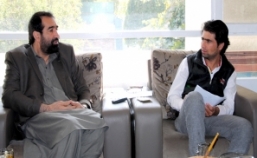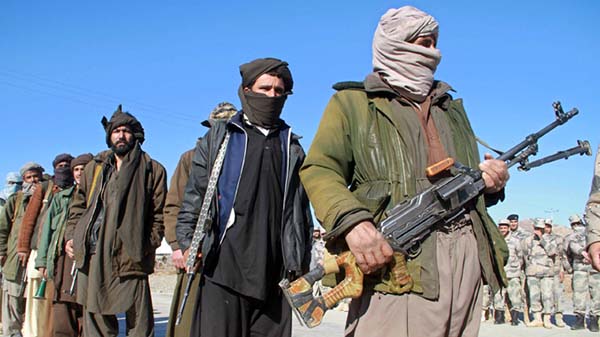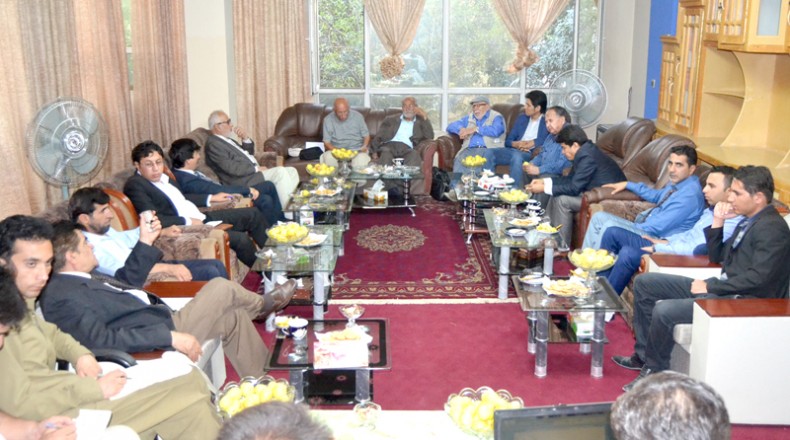Forty percent population has access to regular electricity. To cover all the population Afghanistan needs 5,000 megawatt power.”
By Babar Khan Sahel
KABUL: Many Afghans turn their night into day without having electricity. Afghanistan has the capacity to exploit its own natural resources and produce thousands of megawatt (MW) electricity but the key challenges in this regard are insecurity and weak national economy.
The Minister of Energy and Water, Mohammad Arif Noorzai, said that in Afghanistan there is potential to generate 314,500 MW of electricity from solar, wind and water, but the country still imports 76.26 percent of its power from neighboring countries.
The minister in an exclusive interview with daily Afghanistan Times said that out of the 1,150 MW consuming electricity in the country 250 MW is generated from domestic resources and remaining 900 MW is imported from neighboring countries. Currently, around 40 percent Afghans have access to regular electricity. To provide electricity to all countrymen there is need for 5,000 MW.
He said there is need for more efforts and budget allocation to invest in power sector of the country. “A good management of the power generating resources can make us a major power producing country in the region.”
Solar Energy is the biggest source of power for Afghanistan. He said that 222,000 MW of electricity could be generated from solar energy in the country. At least 300 days are counted as sunny in the year and the remaining 65 days are cloudy. So it is a big and unique potential of Afghanistan to generate enormous amount of electricity from solar panels.
Wind energy is second major electricity generating source in the country. The minister pointed out that 67,000 MW electricity alone could be generated by wind turbines in Afghanistan. Farah province has the potential to generate 18,000 MW of electricity from wind. At least 12,000MW could be generated in Herat province, 10,000MW in Nimroz, and 1,800MW in Helmand.
Hydropower is third source of energy generating. He said Afghanistan have the capacity of generating 23,000 MW electricity through hydropower dams in the country. Additional 2,500MW could be generated from fossil fuel such as natural gas. “In Jawzjan province there is a place where we can generate 200MW electricity.”
As a drive to give chance to private sector to contribute towards energy sector the ministry has started to issue licenses to private firms to invest in energy sector in the country. The ministry has so far issued four licenses to private companies and the process is underway to issue more licenses.
“We have issued license to a company to generate 10 megawatt electricity for Herat Industrial Park. As they have reported they will invest $30 million on the project while they can annually earn $8 million.
To generate one megawatt electricity from solar and wind energy there is need for $2.8 million to $3.5 million. Electricity generating from coal is cheaper than that of the wind and solar.
There is a project of electricity from coal to generate 200MW electricity and the project is estimated to cost $200m in Jawzjan province. The project can be completed within one year, he said.
Explaining the hydropower sources in the country he said that in east, Naghlo Hydropower dam produce 100MW, Mahepar 66MW, Sarobi 22MW and Daronta 10 MW and all the said dams are built on Kabul River. In northern parts of the country, Pul-e-Khumri produce 10MW, Charikar 0.6MW, and Jaba Saraj 3.1MW, in southern provinces: Kajaki dam generate 33 MW, Grishk 4 MW and Baba Wali dam 0.5 MW.
He also said that out of the 900MW importing power from neighboring countries, 300MW is imported from Uzbekistan, 300MW from Tajikistan, 135 from Turkmenistan, and 136MW is imported from Iran.
He also pointed out that a new project is underway to import 300MW electricity from Turkmenistan and the capacity of the project would be increased to 500MW in coming few years. Total $600 million will be spent on the project provided by the Asian Development Bank (ADB). The amount would be spent on installation of transmission lines and the distribution network.
He said there is still need in the country to control and utilize our water resources, because in some areas people faced with lack of water. He said one of the interesting projects was a potable and irrigation canal project named “Nahr-e-Lashkari” in Nimroz province. People in the area were receiving water from Iran, while the water is flowing towards Iran from Afghanistan.
Nahr-e-Lashkari dried five years ago and people in the area were faced with challenges and problems. “Our water was flowing to Iran as river and then Iran gives us back our water through a pipe of four inch. This was an unfortunate and amazing thing for me,” the minister said. Resident were setting up long lines from early 3:00 am to receive water as after morning the water was stopped by Iran and then there were no water for residents.
He said when the ministry was informed about the issue, they started efforts to rehabilitate the canal. Now Nahr-e-Lashkari is fully rehabilitated and people have water in their areas. The canal is 13 km to 15 km long. It was estimated that private firms will reconstruct the canal at a cost of $8 million to $9 million. But the MoWE succeeded to complete the project saving huge amount of money. The machinery for the project was purchased for around $1 million, he noted.
“In addition to providing potable water to more than 50,000 families, the irrigation canal is irrigating 80,000 acres of land in the area. And this was one of the interesting and important projects for me during my work in the ministry,” minister noted.
While providing more details on construction of dams he said that Band-e-Kamal Khan’s (Kamal Khan Dam) second phase will costing $15million, but unfortunately the ministry does not has enough budget for the said project. Third phase of the project need $80 million. With completion of the said project around 155,000 families will find jobs and it would prove as a good source of income for one million people to engage in agriculture activities. In general it would produce grains and food for four million people.
Another important project is construction of a dam on Amu Darya (Oxus River) in bordering area of Afghanistan and Tajikistan in Dasht-e-Joom in Kishm district between Takhar and Badakhshan. Estimated cost for the mega project is $3.5 billion. As per estimation the dam will irrigation more than 80,000 hectares while generating more than 4,000 MW of electricity as well. If constructed the dam has the capacity to earn more money than that spent over construction of the dame within two or three years. American and Chinese private firms are interested to invest in said project. Japan and Korean banks are interested to provide loans in this regard. “We have discussed the issue with Tajikistan and they have no objection, if we build the dam on Amu Darya.” He revealed that Chinese biggest firms have shown readiness to invest on this mega project and they estimated to construct the dam within five years.
He said one KW of electricity is bought from Uzbekistan for $7.9 while Tajikistan gives us on KW for $3.64 and Turkmenistan for $2.
Regarding CASA-1,000 project he said it would transmit around 13,000MW electricity from Kyrgyzstan through Afghanistan to Pakistan. The transit fee per KW is $1.3 that would be paid to Afghanistan by Pakistan. In addition to transit charges Afghanistan would receive 300MW electricity as well. The project would annually add around $45 million to the exchequer.
“We have been engaged in talks with the World Bank and other partners of the project to increase the capacity of the transmission line of CASA from 1,300 to 2,300MW, because by spending $100 million we can transmit additional 1,000MW, but if we install new project it would cost $700 million to $800 million,” he noted.
He pointed out that Salma Dam was one of the important projects of the government, technically and financially supported by India. The dam will irrigate 75,000 hectares of land. Salma dam will generate 42MW electricity and the project is 95 percent completed.
Regarding installation of transmission lines and power network, he said that $180 million have been planned to be spent over installation of a power supply transmission from Ghazni to Zabul and Kandahar. Funds have been provided by the US and it has the capacity to provide electricity to 2.5 million people.
“To provide electricity to south-eastern provinces a project is underway to install transmission line from Kabul through Logar and then to Paktia and finally it will reach Khost province. The United States will spend $130 million on the project,” he said.
About Irrigation and canals construction:
Out of 3,200 under planned irrigation projects, work on 2,300 was completed where more than 500,000 hectares land was brought under irrigation. Nearly, $4 billion had been invested over irrigation projects where work on 2,300 projects has already completed. Out of the four billion US dollars, one billion was provided by the Afghan government and remaining $3 billion by donors including the World Bank and Asian Development Bank.
 Afghanistan Times
Afghanistan Times




